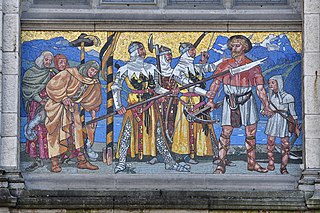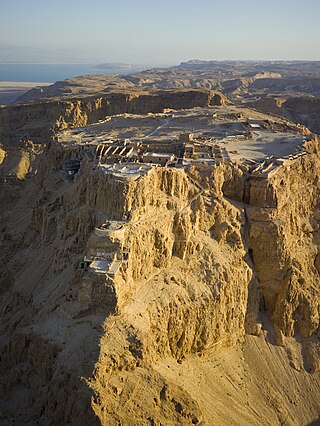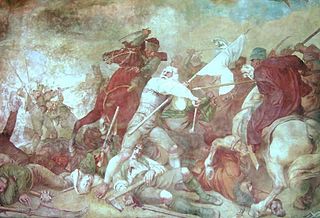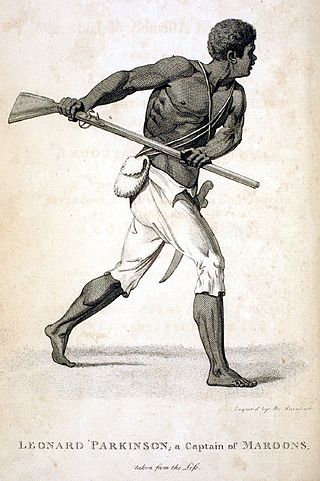
The Massacreof the Innocents is a story recounted in the Nativity narrative of the Gospel of Matthew (2:16–18) in which Herod the Great, king of Judea, orders the execution of all male children who are two years old and under in the vicinity of Bethlehem. Modern scholarship finds no evidence that it happened outside the passages in Matthew, though it is congruous with Herod's character.

William Tell is a folk hero of Switzerland. According to the legend, Tell was an expert mountain climber and marksman with a crossbow who assassinated Albrecht Gessler, a tyrannical reeve of the Austrian dukes of the House of Habsburg positioned in Altdorf, in the canton of Uri. Tell's defiance and tyrannicide encouraged the population to open rebellion and to make a pact against the foreign rulers with neighbouring Schwyz and Unterwalden, marking the foundation of the Swiss Confederacy. Tell was considered the father of the Swiss Confederacy.

The siege of Masada was one of the final events in the First Jewish–Roman War, occurring from 72 to 73 CE on and around a hilltop in present-day Israel.

The Malmedy massacre trial was held in May–July 1946 in the former Dachau concentration camp to try the German Waffen-SS soldiers accused of the Malmedy massacre of 17 December 1944. The highest-ranking defendant was the former Waffen-SS general Sepp Dietrich.

A deal with the Devil, also known as a Faustian bargain, is a cultural motif exemplified by the legend of Faust and the figure of Mephistopheles, as well as being elemental to many Christian traditions. According to traditional Christian belief about witchcraft, the pact is between a person and the Devil or another demon, trading a soul for diabolical favours, which vary by the tale, but tend to include youth, knowledge, wealth, fame and power.

Gashadokuro are mythical creatures in modern Japanese mythology.

The Braunau Parliament is the name of the congress on the defence of the state of Bavaria held at Braunau am Inn convened on 21 December 1705, during the War of the Spanish Succession and often seen as the precursor of the Bavarian parliament.

The European wars of religion were a series of wars waged in Europe during the 16th, 17th and early 18th centuries. Fought after the Protestant Reformation began in 1517, the wars disrupted the religious and political order in the Catholic countries of Europe, or Christendom. Other motives during the wars involved revolt, territorial ambitions and great power conflicts. By the end of the Thirty Years' War (1618–1648), Catholic France had allied with the Protestant forces against the Catholic Habsburg monarchy. The wars were largely ended by the Peace of Westphalia (1648), which established a new political order that is now known as Westphalian sovereignty.

The Serbian Revolution was a national uprising and constitutional change in Serbia that took place between 1804 and 1835, during which this territory evolved from an Ottoman province into a rebel territory, a constitutional monarchy, and modern Serbia.

The Bavarian uprising of 1705–1706 was a revolt against the occupation of the Electorate of Bavaria by the Imperial Army of the Habsburg Monarchy during the War of the Spanish Succession (1701–1714). It lasted from early November 1705 to 18 January 1706, approximately 75 days. Henric L. Wuermeling speaks of this as "the first revolution of modern history."

Coromantee, Coromantins, Coromanti or Kormantine is an English-language term for enslaved people from the Akan ethnic group, taken from the Gold Coast region in modern-day Ghana.

The Great Lakes Patrol was carried out by American naval forces, beginning in 1844, mainly to suppress criminal activity and to protect the maritime border with Canada. A small force of United States Navy, Coast Guard, and Revenue Service ships served in the Great Lakes throughout these operations. Through the decades, they were involved in several incidents with pirates and rebels.

The Simko Shikak revolt refers to an armed Ottoman-backed tribal Kurdish uprising against the Qajar dynasty of Iran from 1918 to 1922, led by Kurdish chieftain Simko Shikak from the Shekak tribe.

The Kosovo Myth, also known as the Kosovo Cult and the Kosovo Legend, is a Serbian national myth based on legends about events related to the Battle of Kosovo (1389). It has been a major subject in Serbian folklore and literary tradition and has been cultivated through oral epic poetry and guslar poems. The final form of the legend was not created immediately after the battle but evolved from different originators into various versions. In its modern form it emerged in 19th-century Serbia and served as an important constitutive element of the national identity of modern Serbia and its politics.
The Avenue Range Station massacre was a murder of a group of Aboriginal Australians by white settlers during the Australian frontier wars. It occurred in about September 1848 at Avenue Range, a sheep station in the southeast of the Colony of South Australia.
Ahmadullah Shah famous as the Maulvi of Faizabad, was a famous freedom fighter and leader of the Indian Rebellion of 1857. Maulavi Ahmadullah Shah was known as the lighthouse of the rebellion in the Awadh region. British officers like George Bruce Malleson and Thomas Seaton made mentions about the courage, valour, personal and organizational capabilities of Ahmadullah. G. B. Malleson mentions Ahmadullah repeatedly in the History of Indian Mutiny, a book written in 6 volumes covering Indian revolt of 1857. Thomas Seaton describes Ahmadullah Shah as:
A man of great abilities, of undaunted courage, of stern determination, and by far the best soldier among the rebels.
A princely rebellion or princely revolt is an intrastate armed conflict by a prince against a reigning monarch of his own family, the ruling dynasty. A prince may rebel against a well-established monarch in order to seize the throne for himself immediately, to ensure his supposed right to sit on the throne in the future, or to secure other rights, privileges or interests such as appanages, alliances or sources of revenue that the monarch allegedly encroached upon, or failed to deliver or guarantee.

The period between the start of the Beeldenstorm in August 1566 until early 1572 contained the first events of a series that would later be known as the Eighty Years' War between the Spanish Empire and disparate groups of rebels in the Habsburg Netherlands. Some of the first pitched battles and sieges between radical Calvinists and Habsburg governmental forces took place in the years 1566–1567, followed by the arrival and government takeover by Fernando Álvarez de Toledo, 3rd Duke of Alba with an army of 10,000 Spanish and Italian soldiers. Next, an ill-fated invasion by the most powerful nobleman of the Low Countries, the exiled but still-Catholic William "the Silent" of Orange, failed to inspire a general anti-government revolt. Although the war seemed over before it got underway, in the years 1569–1571, Alba's repression grew severe, and opposition against his regime mounted to new heights and became susceptible to rebellion.















